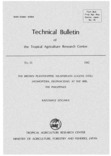Studies on the host resistance-breaking biotypes of the brown planthopper, Nilaparvata lugens (Stål) (Homoptera, Delphacidae) at the IRRI, the Philippines
国名
フィリピン
Technical bulletin of the Tropical Agriculture Research Center
| ISSN | 03889394 |
|---|---|
| 書誌レコードID(総合目録DB) | AA00857848 |

本文フルテキスト
techtarc15-_1-56.pdf12.11 MB
There were no consistent morphological and biochemical characters available as genetic markers to distinguish the three biotypes of the BPH (biotypes 1, 2 and 3) at the IRRI, except for the significant variations in the sucking response to various amino acid-sucrose solutions. Biotypes 2 and 3 appeared to have a wider acceptability to those artificial dietary substrates.
Biotypes were found to differ significantly in their host preference and feeding responses as well as nymphal development and fecundity on the resistant varieties. In particular, the average amount of honeydew excreted on resistant varieties differed among biotypes despite a wide range of individual variations. The different ability of biotypes to suck the resistant varieties was considered to be a crucial factor responsible for their different performance on the resistant varieties. Different reproductive potentials were also found among them not only on resistant varieties but also on susceptible ones. A reproductive disadvantage was loaded by biotype 3.
Hybridization experiments showed that physiological characters of biotypes 2 and 3 were inherited in a recessive or intermediate manner when these were crossed with biotype 1, indicating that the host resistance-breaking biotypes 2 and 3 were not stable in the conditions which allow the coexistence of biotype 1. It could not be clearly demonstrated whether the indefinite segregations in the F2 and back cross progenies were due to the polygenic nature of the traits examined or to the genetic heterogeneity of the biotype populations used.
Biotypes were found to differ significantly in their host preference and feeding responses as well as nymphal development and fecundity on the resistant varieties. In particular, the average amount of honeydew excreted on resistant varieties differed among biotypes despite a wide range of individual variations. The different ability of biotypes to suck the resistant varieties was considered to be a crucial factor responsible for their different performance on the resistant varieties. Different reproductive potentials were also found among them not only on resistant varieties but also on susceptible ones. A reproductive disadvantage was loaded by biotype 3.
Hybridization experiments showed that physiological characters of biotypes 2 and 3 were inherited in a recessive or intermediate manner when these were crossed with biotype 1, indicating that the host resistance-breaking biotypes 2 and 3 were not stable in the conditions which allow the coexistence of biotype 1. It could not be clearly demonstrated whether the indefinite segregations in the F2 and back cross progenies were due to the polygenic nature of the traits examined or to the genetic heterogeneity of the biotype populations used.
| 刊行年月日 | |
|---|---|
| 作成者 | Kazushige Sogawa |
| 公開者 | Tropical Agriculture Research Center |
| 巻 | 15 |
| 開始ページ | 1 |
| 終了ページ | 56 |
| 言語 | eng |
